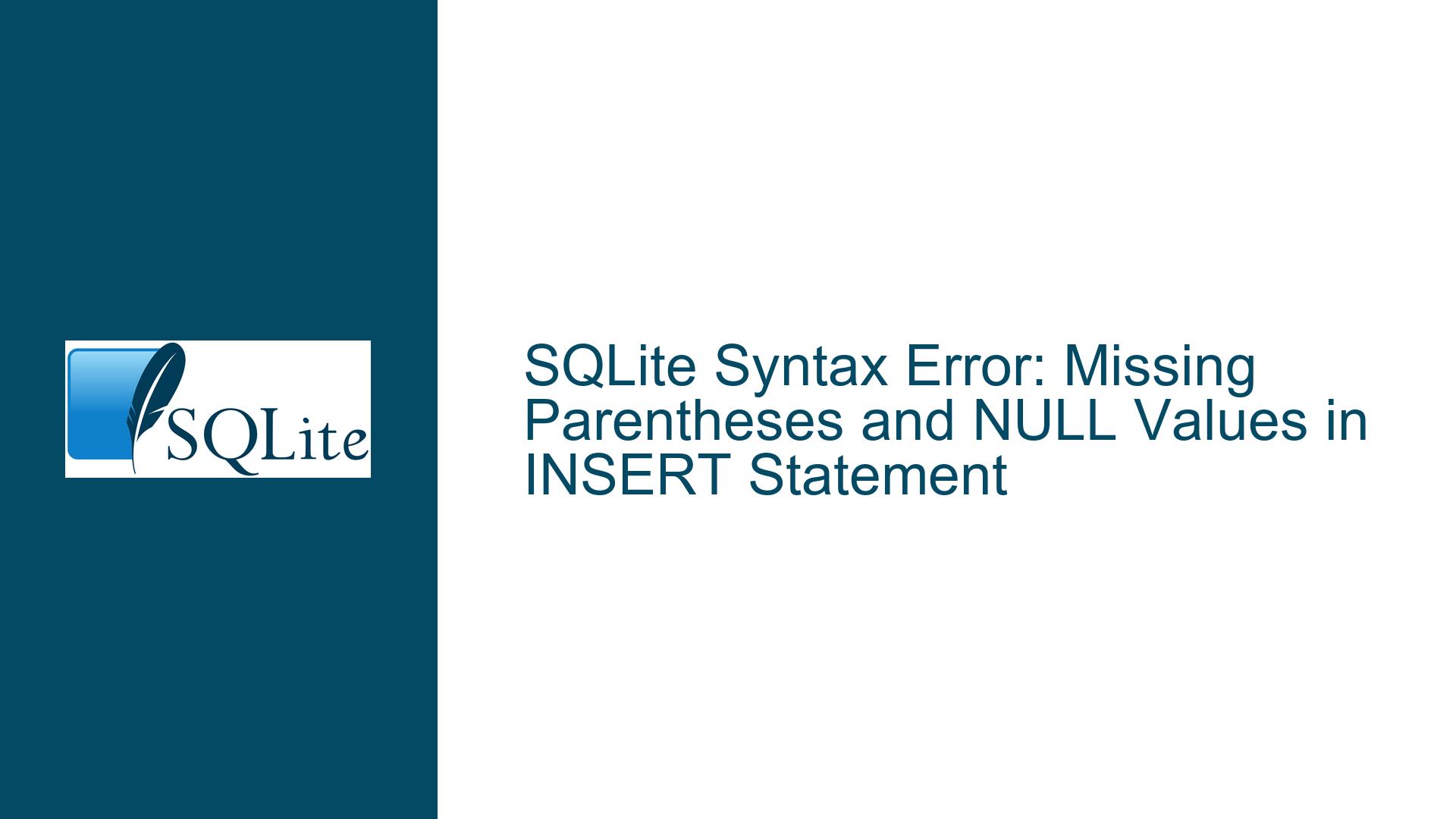SQLite Syntax Error: Missing Parentheses and NULL Values in INSERT Statement
Missing Parentheses and NULL Values in INSERT Statement
When working with SQLite, one of the most common tasks is inserting data into a table using the INSERT INTO statement. However, even experienced developers can encounter syntax errors that are not immediately obvious. In this case, the error message Error: near line 1: near ",": syntax error indicates a problem with the SQL syntax, specifically near a comma. The issue arises from two primary sources: the absence of an opening parenthesis before the column list and the improper handling of NULL values in the VALUES clause.
The INSERT INTO statement in SQLite follows a specific syntax:
INSERT INTO table_name (column1, column2, column3, ...)
VALUES (value1, value2, value3, ...);
In the provided example, the INSERT INTO statement is missing the opening parenthesis before the column list, which is a critical part of the syntax. Additionally, the VALUES clause contains consecutive commas without corresponding values, which is not allowed in SQLite unless the missing values are explicitly set to NULL.
Interrupted Write Operations Leading to Syntax Errors
The error in the INSERT INTO statement can be attributed to two main causes: the absence of an opening parenthesis before the column list and the presence of consecutive commas in the VALUES clause without corresponding values. These issues are often the result of oversight or a misunderstanding of SQLite’s syntax requirements.
The absence of an opening parenthesis before the column list is a straightforward syntax error. SQLite expects the column list to be enclosed in parentheses, and the absence of the opening parenthesis causes the parser to fail, resulting in a syntax error. This is a common mistake, especially when manually writing SQL statements or when copying and pasting from other sources.
The second issue, the presence of consecutive commas in the VALUES clause, is more subtle. In SQLite, consecutive commas without corresponding values are not allowed unless the missing values are explicitly set to NULL. This is because SQLite requires each value in the VALUES clause to correspond to a column in the column list. If a value is missing, it must be explicitly set to NULL to indicate that the column should be left empty.
For example, the following INSERT INTO statement is incorrect:
INSERT INTO Biota (sampid, site_id, sampdate, tclass, torder, tfamily, tgenus, tspecies, subspecies, common_name, ffg, quant)
VALUES (1, 11, '2000-07-18', 'Annelida', 'Oligochaeta', 'Tubificidae', , , , , 'Gatherer', 22);
The correct version of the statement should be:
INSERT INTO Biota (sampid, site_id, sampdate, tclass, torder, tfamily, tgenus, tspecies, subspecies, common_name, ffg, quant)
VALUES (1, 11, '2000-07-18', 'Annelida', 'Oligochaeta', 'Tubificidae', NULL, NULL, NULL, NULL, 'Gatherer', 22);
In the corrected version, the missing values are explicitly set to NULL, which is the correct way to handle missing data in SQLite.
Implementing Proper SQL Syntax and Handling NULL Values
To resolve the syntax error in the INSERT INTO statement, it is essential to ensure that the SQL syntax is correct and that missing values are explicitly set to NULL. Here are the steps to troubleshoot and fix the issue:
Check for Missing Parentheses: The first step is to ensure that the column list in the
INSERT INTOstatement is enclosed in parentheses. The correct syntax is:INSERT INTO table_name (column1, column2, column3, ...) VALUES (value1, value2, value3, ...);In the provided example, the column list should be enclosed in parentheses:
INSERT INTO Biota (sampid, site_id, sampdate, tclass, torder, tfamily, tgenus, tspecies, subspecies, common_name, ffg, quant) VALUES (1, 11, '2000-07-18', 'Annelida', 'Oligochaeta', 'Tubificidae', NULL, NULL, NULL, NULL, 'Gatherer', 22);Handle NULL Values Properly: The second step is to ensure that missing values in the
VALUESclause are explicitly set toNULL. Consecutive commas without corresponding values are not allowed in SQLite. Instead, each missing value should be set toNULL:INSERT INTO Biota (sampid, site_id, sampdate, tclass, torder, tfamily, tgenus, tspecies, subspecies, common_name, ffg, quant) VALUES (1, 11, '2000-07-18', 'Annelida', 'Oligochaeta', 'Tubificidae', NULL, NULL, NULL, NULL, 'Gatherer', 22);Validate the Column List: Ensure that the number of columns in the column list matches the number of values in the
VALUESclause. In the provided example, there are 12 columns and 12 values, which is correct. However, if the number of columns and values do not match, SQLite will throw a syntax error.Use SQLite’s PRAGMA Statements: SQLite provides several PRAGMA statements that can help diagnose and resolve issues with the database. For example, the
PRAGMA foreign_keysstatement can be used to enable or disable foreign key constraints, and thePRAGMA integrity_checkstatement can be used to check the integrity of the database. These PRAGMA statements can be useful when troubleshooting issues with the database schema or data.Test the SQL Statement: After making the necessary corrections, test the SQL statement to ensure that it executes without errors. If the statement still produces an error, review the syntax and ensure that all values are correctly specified.
Use SQLite’s Error Messages: SQLite provides detailed error messages that can help identify the source of the problem. In the provided example, the error message
Error: near line 1: near ",": syntax errorindicates that there is a syntax error near a comma. This error message can be used to pinpoint the location of the error in the SQL statement.Consider Using Prepared Statements: Prepared statements can help prevent syntax errors by allowing you to parameterize the SQL statement. This can be particularly useful when inserting data into a table, as it allows you to specify the values separately from the SQL statement. Prepared statements can also improve performance by reducing the overhead of parsing and compiling the SQL statement.
Review the Database Schema: Ensure that the database schema is correctly defined and that the table and columns exist. If the table or columns do not exist, SQLite will throw an error. The
sqlite_mastertable can be queried to view the schema of the database:SELECT sql FROM sqlite_master WHERE type = 'table' AND name = 'Biota';This query will return the SQL statement used to create the
Biotatable, which can be used to verify that the table and columns exist.Use SQLite’s Command-Line Interface: SQLite’s command-line interface (CLI) can be used to interact with the database and execute SQL statements. The CLI provides a convenient way to test SQL statements and view the results. For example, the following command can be used to execute the
INSERT INTOstatement:sqlite3 testing.db "INSERT INTO Biota (sampid, site_id, sampdate, tclass, torder, tfamily, tgenus, tspecies, subspecies, common_name, ffg, quant) VALUES (1, 11, '2000-07-18', 'Annelida', 'Oligochaeta', 'Tubificidae', NULL, NULL, NULL, NULL, 'Gatherer', 22);"This command will execute the
INSERT INTOstatement and insert the data into theBiotatable.Consider Using an ORM: Object-Relational Mapping (ORM) tools can help simplify the process of interacting with the database by allowing you to work with objects instead of writing raw SQL statements. ORM tools can also help prevent syntax errors by generating the SQL statements for you. Some popular ORM tools for SQLite include SQLAlchemy and Peewee.
By following these steps, you can troubleshoot and resolve syntax errors in SQLite’s INSERT INTO statement. Ensuring that the SQL syntax is correct and that missing values are explicitly set to NULL will help prevent errors and ensure that the data is correctly inserted into the table.






